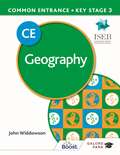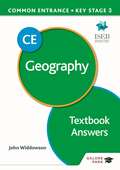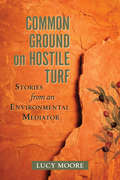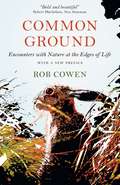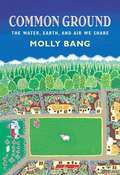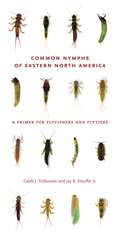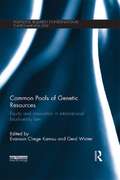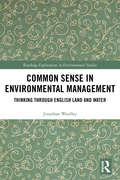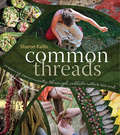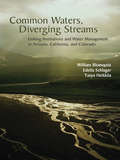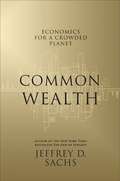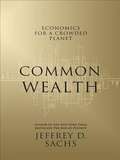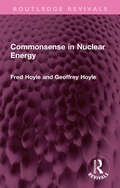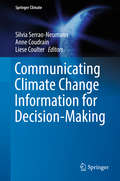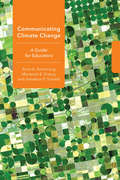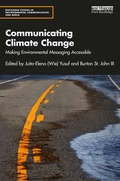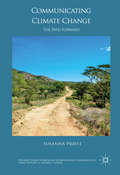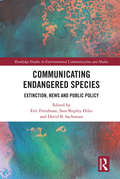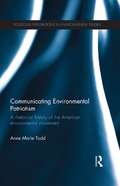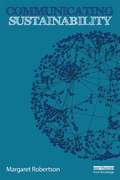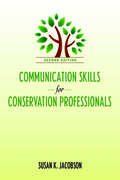- Table View
- List View
Common Entrance 13+ Geography for ISEB CE and KS3
by John WiddowsonExam board: ISEB Level: 13+ CE and KS3 Subject: Geography First teaching: September 2021 First exams: November 2022Trust John Widdowson and his extensive experience in Common Entrance to guide you through the new ISEB 13+ CE Geography specification so you can help your pupils build confidence, proficiency and a love of Geography with the new Geography series for Common Entrance at 13+ and Key Stage 3.- Support new specification content on the issues tomorrow's geographers will face: A new chapter on the environment looks at local, national and global issues, focusing on sustainability and stewardship (a new addition to the 13+ CE specification for first examination from November 2022).- Push your pupils to achieve the best results: The new 'Your challenge' feature offers additional tasks to stretch pupils.- Cover all the content for human and physical Geography in one book: A more convenient and cost-effective approach for teachers and pupils. - Develop your pupils' investigative skills: An enquiry-based approach encourages pupils to develop their investigative skills.- Guide your pupils to think and work like geographers: The emphasis on geographical skills such as map reading and using sources and resources (for example, interpreting graphs, photos and maps) helps your pupils apply their knowledge.- Beautifully illustrated with engaging visuals: Packed with clear photos, maps and charts to aid learning and recall. Accompanying answers available as a paid-for PDF download at galorepark.co.uk (ISBN: 9781398322127).
Common Entrance 13+ Geography for ISEB CE and KS3
by John WiddowsonExam board: ISEB Level: 13+ CE and KS3 Subject: Geography First teaching: September 2021 First exams: November 2022Trust John Widdowson and his extensive experience in Common Entrance to guide you through the new ISEB 13+ CE Geography specification so you can help your pupils build confidence, proficiency and a love of Geography with the new Geography series for Common Entrance at 13+ and Key Stage 3.· Support new specification content on the issues tomorrow's geographers will face: A new chapter on the environment looks at local, national and global issues, focusing on sustainability and stewardship (a new addition to the 13+ CE specification).· Motivate your pupils to excel: The new 'Your Challenge' feature offers additional tasks for high achieving pupils.· Cover all the content for human and physical Geography in one book: A more convenient and cost-effective approach for teachers and pupils.· Develop your pupils' investigative skills: An enquiry-based approach encourages pupils to develop these key skills.· Guide your pupils to think and work like geographers: The emphasis on enquiry and geographical skills such as map reading will help take your pupils to the next level.· Beautifully illustrated with engaging visuals: Packed with clear photos, maps and charts to aid learning and recall.Accompanying answers available as a paid-for PDF download at galorepark.co.uk (ISBN: 9781398322127).
Common Entrance 13+ Geography for ISEB CE and KS3 Textbook Answers
by John WiddowsonThis PDF download contains full answers to all questions in Common Entrance 13+ Geography for ISEB CE and KS3 (ISBN: 9781398322073).· Answers and indicative content.· Clear layout saves time marking work and allows you to efficiently assess pupils' strengths and weaknesses.· A sample Scheme of Work presents the CE content which must be covered in preparation for CE 13+. It is possible to deliver the content in a number of different ways and we present an option that can be followed or adapted.As a downloadable PDF, please note this resource is non-refundable.
Common Entrance 13+ Geography for ISEB CE and KS3 Textbook Answers
by John WiddowsonThis resource contains full answers to all questions in Common Entrance 13+ Geography for ISEB CE and KS3 (ISBN: 9781398322073).· Answers and indicative content.· Clear layout saves time marking work and allows you to efficiently assess pupils' strengths and weaknesses.· A sample Scheme of Work presents the CE content which must be covered in preparation for CE 13+. It is possible to deliver the content in a number of different ways and we present an option that can be followed or adapted.Please note this resource is non-refundable.
Common Ground in a Liquid City
by Matt HernIf we want to preserve what's still left of the natural world, we need to stop using so much of it. And, says veteran environmental activist Matt Hern, cities are the best chance we have left for a truly ecological future . . . but what does it take to make a truly sustainable city?Common Ground in a Liquid City is a fun and engaging look at the future of urban life. Hern takes us on a journey through over a dozen urban centers, from Vancouver to Istanbul, Las Vegas, and beyond, exploring the history and current composition of cities around the globe and highlighting the elements of each that make it livable.Each of Hern's ten chapters focuses on a central theme of city life: diversity, street life, crime, population density, water and natural life, gentrification, and globalism. What emerges in the end is an appealing portrait of what the urban future might look like--environmentally friendly, locally focused, and governed from below.Matt Hern is an inveterate city dweller and an environmental and education activist. The editor of Everywhere All the Time: A New Deschooling Reader and the author of Deschooling Our Lives and Field Day, he founded Vancouver's Car-Free Day and is the director of the Purple Thistle Center for alternative education. These days, he lives in Vancouver with his partner and daughters and lectures widely around the globe.
Common Ground on Hostile Turf: Stories from an Environmental Mediator
by Lucy MooreIn our increasingly polarized society, there are constant calls for compromise, for coming together. For many, these are empty talking points--for Lucy Moore, they are a life's work. As an environmental mediator, she has spent the past quarter century resolving conflicts that appeared utterly intractable. Here, she shares the most compelling stories of her career, offering insight and inspiration to anyone caught in a seemingly hopeless dispute. Moore has worked on wide-ranging issues--from radioactive waste storage to loss of traditional grazing lands. More importantly, she has worked with diverse groups and individuals: ranchers, environmental activists, government agencies, corporations, tribal groups, and many more. After decades spent at the negotiating table, she has learned that a case does not turn on facts, legal merit, or moral superiority. It turns on people. Through ten memorable stories, she shows how issues of culture, personality, history, and power affect negotiations. And she illustrates that equitable solutions depend on a healthy group dynamic. Both the mediator and opposing parties must be honest, vulnerable, open, and respectful. Easier said than done, but Moore proves that subtle shifts can break the logjam and reconcile even the most fiercely warring factions. This book should be especially appealing to anyone concerned with environmental conflicts; and also to students in environmental studies, political science, and conflict resolution, and to academics and professionals in mediation and conflict resolution fields.
Common Ground: Encounters with Nature at the Edges of Life
by Rob CowenAll too often, we think of nature as something distinct from ourselves, something to go and see, a place that’s separate from the ordinary modern world in which we live and work. But if we take the time to look, we soon find that’s not how nature works. Even in our parceled-out, paved-over urban environs, nature is all around us; it is in us. It is us. That’s what Rob Cowen discovered after moving to a new home in northern England. After ten years in London he was suddenly adrift, searching for a sense of connection. He found himself drawn to a square-mile patch of waste ground at the edge of town. Scrappy, weed-filled, this heart-shaped tangle of land was the very definition of overlooked—a thoroughly in-between place that capitalism no longer had any use for, leaving nature to take its course. Wandering its meadows, woods, hedges, and fields, Cowen found it was also a magical, mysterious place, haunted and haunting, abandoned but wildly alive—and he fell in fascinated love. Common Ground is a true account of that place and Cowen’s transformative journey through its layers and lives, but it’s much more too. As the land’s stories intertwine with events in his own life—and he learns he is to become a father for the first time—the divisions between human and nature begin to blur and shift. The place turns out to be a mirror, revealing what we are, what we’re not and how those two things are ultimately inseparable. This is a book about discovering a new world, a forgotten world on the fringes of our daily lives, and the richness that comes from uncovering the stories and lives—animal and human—contained within. It is an unforgettable piece of nature writing, part of a brilliant tradition that stretches from Gilbert White to Robert Macfarlane and Helen Macdonald. “I am dreaming of the edge-land again,” Cowen writes. Read Common Ground, and you, too, will be dreaming of the spaces in between, and what—including us—thrives there.
Common Ground: The Water, Earth And Air We Share
by Molly BangFrom the Caldecott Honor author Molly Bang, author-illustrator of the critically acclaimed Sunlight Series, this is a simple story of our planet's natural resources. Through the example of a shared village green and the growing needs of the townspeople who share it, Molly Bang presents the challenge of handling our planet's natural resources. With jewel-like paintings and simple text, Bang impresses upon us the urgency of conserving and preserving our earth's limited bounty.
Common Nymphs of Eastern North America: A Primer for Flyfishers and Flytiers (Keystone Books)
by Caleb J. Tzilkowski Jay R. Stauffer Jr.Although the concept of “matching the hatch” has been central to flyfishing for 150 years, it has been used almost exclusively for dry flyfishing. With Common Nymphs of Eastern North America: A Primer for Flyfishers and Flytiers, Caleb Tzilkowski and Jay Stauffer Jr. take trout enthusiasts in another hatch-matching direction—to the year-round underwater nymph “hatch,” which, in most cases, constitutes 90 percent of trout diets. Successful flyfishers have at least rudimentary knowledge of the organisms that artificial flies imitate. The relatively few and very best anglers are expert at identifying and imitating nymph appearances and habits. A major hurdle to becoming expert at nymph matching is overcoming two major limitations that make these animals difficult to locate, capture, and identify: first, nymphs live underwater, sometimes burrowed into the stream bottom, and second, many nymphs are nearly microscopic in size. Common Nymphs addresses those challenges by including habitat and life history information regarding the nymphs, tips for their identification, and representative high-resolution photographs of more than thirty types of aquatic organisms and their imitations.In the seemingly saturated flyfishing literature, this book offers something truly groundbreaking. With state-of-the-art microscopy and their years of scientific and practical experience, Tzilkowski and Stauffer provide readers an innovative close-up look at identifying and imitating nymphs that have been historically underrepresented in the flyfishing and flytying literature.
Common Pool Resources: Strategic Behavior, Inefficiencies, and Incomplete Information
by Felix Muñoz-Garcia Ana Espinola-ArredondoCommon Pool Resources include, for instance, fishing grounds, irrigation systems, forests and the atmosphere. Now more than ever, how we responsibly share and use those goods is a vital issue. This textbook introduces students of economics, business and policy studies to the key issues in the field. It uses a game-theory approach to help readers understand the mathematical representation of how to find equilibrium behavior in CPRs, how to identify the socially optimal appropriation, and how to measure the inefficiencies that arise. Algebra and calculus steps are clearly explained, so students can more easily reproduce the analysis and apply it in their own research. Finally, the book also summarizes experimental studies that tested theoretical results in controlled environments, introducing readers to a literature that has expanded over the last decades, and provides references for further reading.
Common Pools of Genetic Resources: Equity and Innovation in International Biodiversity Law (Routledge Research in International Environmental Law)
by Gerd Winter Evanson Chege KamauThe Convention on Biological Diversity (CBD) strives for the sustainable and equitable utilization of genetic resources, with the ultimate goal of conserving biodiversity. The CBD and the Nagoya Protocol which has since been elaborated suggest a bilateral model for access to genetic resources and the sharing of benefits from their utilization. There is concern that the bilateral exchange "genetic resource for benefit sharing" could have disappointing results because providers are left out of the process of research and development, benefits are difficult to be traced to sources, and providers owning the same resource may complain of being excluded from benefit sharing. Thus, the CBD objective of full utilization and equitability may become flawed. Common Pools of Genetic Resources: Equity and Innovation in International Biodiversity Law suggests common pools as a complementary approach to bilateralism. This is one of the first books to reply to a number of complex legal questions related to the interpretation and implementation of the Nagoya Protocol. Taking an inductive approach, it describes existing pools and analyzes how they are organized and how they perform in terms of joint R&D and benefit sharing. It presents case studies of the most characteristic types of common pools, provides suggestions for further developing existing pools to cope with the requirements of the CBD and NP and, at the same time uses the clauses these conventions contain to open up for commons approaches. Written by a team of expert academics and practitioners in the field, this innovative book makes a timely and valuable contribution to academic and policy debates in international environmental law, international biodiversity law, intellectual property law, climate law and the law of indigenous populations.
Common Sense in Environmental Management: Thinking Through English Land and Water (Routledge Explorations in Environmental Studies)
by Jonathan WoolleyCommon Sense in Environmental Management examines common sense not in theory, but in practice. Jonathan Woolley argues that common sense as a concept is rooted in English experiences of landscape and land management and examines it ethnographically - unveiling common sense as key to understanding how British nature and public life are transforming in the present day. Common sense encourages English people to tacitly assume that the management of land and other resources should organically converge on a consensus that yields self-evident, practical results. Furthermore, the English then tend to assume that their own position reflects that consensus. Other stakeholders are not seen as having legitimate but distinct expertise and interests – but are rather viewed as being stupid and/or immoral, for ignoring self-evident, pragmatic truths. Compromise is therefore less likely, and land management practices become entrenched and resistant to innovation and improvement. Through a detailed ethnographic study of the Norfolk Broads, this book explores how environmental policy and land management in rural areas could be more effective if a truly common sense was restored in the way we manage our shared environment. Using academic and lay deployments of common sense as a route into the political economy of rural environments, this book will be of great interest to scholars and students of socio-cultural anthropology, sociology, human geography, cultural studies, social history, and the environmental humanities.
Common Threads
by Sharon KallisDisposing of unwanted natural materials can be expensive and time-consuming, or it can present a tremendous opportunity for creating collaborative eco-art. Invasive-species control, green-waste management, urban gardening, and traditional crafts can all be brought together to strengthen community relationships and foster responsible land stewardship. Simple, easily taught, creative techniques applied with shared purpose become the modern-day equivalent of a barn raising or a quilting bee.Common Threads is a unique guide to engaging community members in communal handwork for the greater good. Sharon Kallis provides a wealth of ideas for: Working with unwanted natural materials, with an emphasis on green waste and invasive species Visualizing projects that celebrate the human element while crafting works of art or environmental remediation Creating opportunities for individuals to connect with nature in a unique, meditative, yet community-oriented wayCombining detailed, step-by-step instructions with tips for successful process and an overview of completed projects, Common Threads is a different kind of weaving book. This inspirational guide is designed to help artists and activists foster community, build empowerment, and develop a do-it-together attitude while planning and implementing works of collaborative eco-art.Sharon Kallis is a Vancouver artist who specializes in working with unwanted natural materials. Involving community in connecting traditional hand techniques with invasive species and garden waste, she creates site-specific installations that become ecological interventions. Her recent projects include The Urban Weaver Project, Aberthau: flax=food+fibre, and working closely with fiber artists, park ecologists, First Nations basket weavers, and others.
Common Waters, Diverging Streams: Linking Institutions and Water Management in Arizona, California, and Colorado
by Tanya Heikkila William Blomquist Edella SchlagerThis book is a firsthand investigation into water management in a fast-growing region of the arid American West. It presents three states that have adopted the conjunctive management of groundwater and surface water to make resources go further in serving people and the environment. Yet conjunctive management has followed a different history, been practiced differently, and produced different outcomes in each state. The authors question why different results have emerged from neighbors trying to solve similar problems with the same policy reform. Common Waters, Diverging Streams makes several important contributions to policy literature and policymaking. The first book on conjunctive water management, it describes how the policy came into existence, how it is practiced, what it does and does not accomplish, and how institutional arrangements affect its application. A second contribution is the book's clear and persuasive links between institutions and policy outcomes. Scholars often declare that institutions matter, but few articles or books provide an explicit case study of how policy linkages work in actual practice. In contrast, Blomquist, Schlager, and Heikkila show how diverging courses in conjunctive water management can be explained by state laws and regulations, legal doctrines, the organizations governing and managing water supplies, and the division of authority between state and local government. Not only do these institutional structures make conjunctive management easier or harder to achieve, but they influence the kinds of problems people try to solve and the purposes for which they attempt conjunctive management.
Common Wealth: Economics for a Crowded Planet
by Jeffrey D. SachsA set of practical solutions based on a new economic paradigm for our crowded planet, from an assessment of the environmental degradation, rapid population growth, and extreme poverty that threaten global peace and prosperity
Common Wealth: Economics for a Crowded Planet
by Jeffrey D. SachsThis is a book about how we should address the great, and interconnected, global challenges of the twenty-first century. Our task, Sachs argues, is to achieve truly sustainable development, by which he means finding a global course which enables the world to benefit from the spread of prosperity while ensuring that we don't destroy the eco-systems which keep us alive and our place in nature which helps sustain our values. How do we move forward together, benefitting from our increasing technological mastery, avoiding the terrible dangers of climate change, mass famines, violent conflicts, population explosions in some parts of the world and collapses in others, and world-wide pandemic diseases? In answering these questions, Sachs shows that there are different ways of managing the world's technology, resources and politics from those currently being followed, and that it should be possible to adopt policies which reflect long-term and co-operative thinking instead of, as currently, disregard for others and ever-increasing barriers to solving the problems which we collectively face. It is a book which appeals equally to both head and heart, and one which no globally thinking person can ignore.
Commonsense in Nuclear Energy (Routledge Revivals)
by Fred Hoyle Geoffrey HoyleOriginally published in 1979, written at a time when the world stood on the brink of (another) energy crisis, this book argued that an alternative primary fuel had to be found and that the answer lay in the exploitation of nuclear fission. The book sought to dispel the anxieties of environmentalists by correcting what the authors felt were basic misconceptions about nuclear energy. The book distinguishes carefully between nuclear energy and nuclear explosions, as the authors believed that it was the confusion between these two very different things which lies at the root of most opposition to nuclear energy. The Relevant facts concerning nuclear energy are presented in a straightforward way and the case made that nuclear energy can be clean and safe. The book includes a discussion of the storage of nuclear waste and the safety record of the nuclear industry.
Communicating Climate Change Information for Decision-Making (Springer Climate)
by Silvia Serrao-Neumann Anne Coudrain Liese CoulterThis book provides important insight on a range of issues focused on three themes; what new climate change information is being developed, how that knowledge is communicated and how it can be usefully applied across international, regional and local scales. There is increasing international investment and interest to develop and communicate updated climate change information to promote effective action. As change accelerates and planetary boundaries are crossed this information becomes particularly relevant to guide decisions and support both proactive adaptation and mitigation strategies. Developing new information addresses innovations in producing interdisciplinary climate change knowledge and overcoming issues of data quality, access and availability. This book examines effective information systems to guide decision-making for immediate and future action. Cases studies in developed and developing countries illustrate how climate change information promotes immediate and future actions across a range of sectors.
Communicating Climate Change: A Guide for Educators (Cornell Series in Environmental Education)
by Marianne E. Krasny Anne K. Armstrong Jonathon P. SchuldtEnvironmental educators face a formidable challenge when they approach climate change due to the complexity of the science and of the political and cultural contexts in which people live. There is a clear consensus among climate scientists that climate change is already occurring as a result of human activities, but high levels of climate change awareness and growing levels of concern have not translated into meaningful action. Communicating Climate Change provides environmental educators with an understanding of how their audiences engage with climate change information as well as with concrete, empirically tested communication tools they can use to enhance their climate change program.Starting with the basics of climate science and climate change public opinion, Armstrong, Krasny, and Schuldt synthesize research from environmental psychology and climate change communication, weaving in examples of environmental education applications throughout this practical book. Each chapter covers a separate topic, from how environmental psychology explains the complex ways in which people interact with climate change information to communication strategies with a focus on framing, metaphors, and messengers. This broad set of topics will aid educators in formulating program language for their classrooms at all levels. Communicating Climate Change uses fictional vignettes of climate change education programs and true stories from climate change educators working in the field to illustrate the possibilities of applying research to practice. Armstrong et al, ably demonstrate that environmental education is an important player in fostering positive climate change dialogue and subsequent climate change action.Thanks to generous funding from Cornell University, the ebook editions of this book are available as Open Access from Cornell Open (cornellopen.org) and other Open Access repositories.
Communicating Climate Change: Making Environmental Messaging Accessible (Routledge Studies in Environmental Communication and Media)
by Juita-Elena Wie Yusuf And Burton St. John IIIThis edited collection focuses on theoretical and applied research-based observations concerning how experts, advocates, and institutions make climate change information accessible to different audiences. Communicating Climate Change concentrates on three key elements of climate change communication – access, relevance, and understandability – to provide an overview of how these aspects allow multiple groups of stakeholders to act on climate-related information to build resilience. Featuring contributions from a wide range of scholars from across different disciplines, this book explores a multitude of different scenarios and communication methods, including social media; public opinion surveys; participatory mapping; and video. Overall, climate change communication is addressed from three different perspectives: communicating with the public; communicating for stakeholder engagement; and organizational, institutional, risk, and disaster communication. With each chapter focusing on implications and applications for practice, this book will be of great interest to students and researchers of climate change and environmental communication, as well as practitioners interested in understanding how to better engage stakeholders through climate change-related communication.
Communicating Climate Change: The Path Forward (Palgrave Studies in Media and Environmental Communication)
by Susanna PriestThis book asks and answers the question of what communication research and other social sciences can offer that will help the global community to address climate change by identifying the conditions that can persuade audiences and encourage collective action on climate. While scientists often expect that teaching people the scientific facts will change their minds about climate change, closer analysis suggests this is not always the case. Communication scholars are pursuing other ideas based on what we know about influence and persuasion, but this approach does not provide complete answers either. Some misconceptions can be corrected by education, and some messages will be more powerful than others. The advent of the Internet also makes vast stores of information readily available. But audiences still process this information through different filters, based on their own values and beliefs - including their understanding of how science works. In between momentous events, media coverage of climate tends to recede and individuals turn their attention back to their daily lives. Yet there is a path forward: Climate change is a social justice issue that no individual - and no nation - can solve on their own. A different sort of communication effort can help.
Communicating Endangered Species: Extinction, News and Public Policy (Routledge Studies in Environmental Communication and Media)
by Eric Freedman; Sara Shipley Hiles; David B. SachsmanCommunicating Endangered Species: Extinction, News, and Public Policy is a multidisciplinary environmental communication book that takes a distinctive approach by connecting how media and culture depict and explain endangered species with how policymakers and natural resource managers can or do respond to these challenges in practical terms. Extinction isn’t new. However, the pace of extinction is accelerating globally. The International Union for Conservation of Nature classifies more than 26,000 species as threatened. The causes are many, including climate change, overdevelopment, human exploitation, disease, overhunting, habitat destruction, and predators. The willingness and the ability of ordinary people, governments, scientists, nongovernmental organizations, and businesses to slow this deeply disturbing acceleration are uncertain. Meanwhile, researchers around the world are laboring to better understand and communicate the possibility and implications of extinctions and to discover effective tools and public policies to combat the threats to species survival. This book presents a history of news coverage of endangered species around the world, examining how and why journalists and other communicators wrote what they did, how attitudes have changed, and why they have changed. It draws on the latest research by chapter authors who are a mix of social scientists, communication experts, and natural scientists. Each chapter includes a mass media and/or cultural aspect. This book will be essential reading for students, natural resource managers, government officials, environmental activists, and academics interested in conservation and biodiversity, environmental communication and journalism, and public policy.
Communicating Environmental Patriotism: A Rhetorical History of the American Environmental Movement (Routledge Explorations in Environmental Studies)
by Anne Marie ToddEnvironmental patriotism, the belief that the national environment defines a country’s greatness, is a significant strand in twentieth century American environmentalism. This book is the first to explore the history of environmental patriotism in America through the intriguing stories of environmental patriots and the rhetoric of their speeches and propaganda, The See America First movement began in 1906 with the aim of protecting and promoting the landscapes of the American West. In 1908, Gifford Pinchot and President Theodore Roosevelt hosted the White House Conservation Conference to promote the wise use of natural resources for generations of Americans. In 1912, Pittsburgh’s smoke investigation condemned the effects of coal smoke on the city’s environment. In World War II, a massive propaganda effort mobilized millions of Americans to plant victory gardens to save resources for the war abroad. While these may not seem like crucial moments for the American environmental movement, this new history of American environmentalism shows that they are linked by patriotism. The book offers a provoking critique of environmentalists’ communication strategies and suggests patriotism as a persuasive hook for new ways to make environmental issues a national priority. This original research should be of interest to scholars of environmental communication, environmental history, American history and environmental philosophy.
Communicating Sustainability: Making Sustainability Legible
by Margaret RobertsonCommunicating Sustainability is a book of evidence-based strategies for making sustainability vivid, accessible, and comprehensible. To do this, it brings together research from a range of specialties including cognitive psychology, visual perception, communication studies, environmental design, interpretive exhibit design, interpretive signage, wayfinding, storytelling, courtroom litigation, information graphics, and graphic design to illustrate not only what approaches are effective but why they work as they do. The topic of sustainability is vast and complex. It interconnects multiple dimensions of human culture and the biosphere and involves a myriad of systems and processes, many of which are too large, too small, too fast, or too slow to see. Many people find verbal explanations about all of this too abstract or too complicated to understand, and for most people the concepts of sustainability are regarded as quirky, peripheral, and not essential to everyday life. Yet the challenges of sustainability concern the very survival of most species of life on Earth, including the human species. In order for life as we know it to survive and thrive into the future, sustainability must become broadly understood—by everyone, not just activists or specialists. This book offers tools to help make complex systems and nuanced, abstract ideas concrete and comprehensible to the broadest range of people. The goal of communication, and of this book, is to build understanding.
Communication Skills for Conservation Professionals
by Susan Kay JacobsonWhether you are managing wetlands, protecting endangered species, or restoring ecosystems, you need to be able to communicate effectively in order to solve conservation and resource management problems. Communication Skills for Conservation Professionals can help you do just that--it is a practical and inspiring book that provides user-friendly guidance on achieving conservation goals through effective communication. Following introductory chapters that draw on research from communication, psychology, sociology, and education to highlight elements critical for effective communication, the book describes how to gather background information and target audiences, explains how public relations can influence attitudes and behaviors, and outlines how to design and conduct a communications campaign. In addition, it provides step-by-step guidance for using print, broadcast, and electronic mass media; demonstrates methods for developing public talks, interpretive brochures, exhibits, and trails; and explores long-term conservation education strategies for students and adults. This second edition of a widely praised book, originally published in 1999, includes new material on working with stakeholders, volunteers, and other groups to multiply conservation success. It also expands on the use of electronic media with examples of conservation Web pages, blogs, e-newsletters, and other new media. The book's citations have been updated to include a host of Web sites and other electronic sources useful for planning and implementing communication programs. Communication Skills for Conservation Professionals is a valuable addition to the conservationist's toolbox that will help scientists, managers, concerned citizens, and students communicate more effectively.
